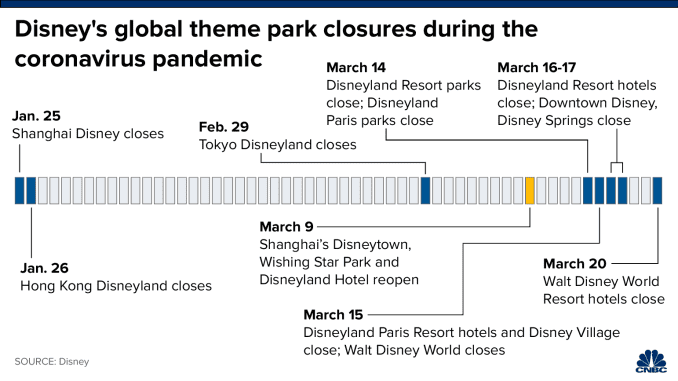KEY POINTS
Disney theme parks are closed as the coronavirus continues to spread across the United States on March 14, 2020 in Anaheim, California.
Rich Fury | Getty Images
The coronavirus pandemic has crippled the theme park industry, including the top amusement company in the world, Disney
On Tuesday, the company said the Covid-19 outbreak caused its Parks, Experiences and Consumer Products segment to lose around $1 billion in revenue during the second quarter after its parks, cruises and stores were forced to close.
The Parks, Experiences and Consumer Products segment includes all six of Disney’s international theme parks, its cruise lines, hotels and tours, as well as its merchandise. Last year, this segment accounted for 37% of the company’s $69.6 billion in total revenue.
In fiscal second-quarter ended March 28, Disney reported a 10% drop in this segment, with revenue falling to $5.54 billion.
The company also reported 58% drop in operating income for Parks, Experiences and Consumer Products this quarter compared to the same period last year. Until recently, it was Disney’s fastest-growing profit driver.

“The impact of COVID-19 and measures to prevent its spread are affecting our segments in a number of ways, most significantly at Parks, Experiences and Products where we have closed our theme parks and retail stores, suspended cruise ship sailings and guided tours and experienced supply chain disruptions,” the company said in an earnings statement Tuesday.
The first theme park closures Disney faced were in Asia. On Jan. 25, the company was forced to close Shanghai Disney. Hong Kong Disneyland closed a day later. By Feb. 29, Disney shuttered Tokyo Disneyland, due to growing social distancing restrictions in Japan.
Then, on March 14, the company closed Disneyland in California and Disneyland Paris. Walt Disney World closed to the public on March 15.
On Tuesday, Disney announced that Shanghai Disneyland would reopen on May 11.
“As we look ahead, while we have announced plans to reopen Shanghai Disney Resort, there is limited visibility into the timing of reopening and the conditions under which we can reopen the rest of our Parks and Resorts, cruise ships and Disney stores,” Christine McCarthy, chief financial officer at Disney, said during the call.

- Disney said the Covid-19 outbreak caused its Parks, Experiences and Consumer Products segment to lose around $1 billion in revenue during the second quarter.
- The company’s parks, cruises and stores have been forced to close due to global social distancing restrictions.
Disney theme parks are closed as the coronavirus continues to spread across the United States on March 14, 2020 in Anaheim, California.
Rich Fury | Getty Images
The coronavirus pandemic has crippled the theme park industry, including the top amusement company in the world, Disney
On Tuesday, the company said the Covid-19 outbreak caused its Parks, Experiences and Consumer Products segment to lose around $1 billion in revenue during the second quarter after its parks, cruises and stores were forced to close.
The Parks, Experiences and Consumer Products segment includes all six of Disney’s international theme parks, its cruise lines, hotels and tours, as well as its merchandise. Last year, this segment accounted for 37% of the company’s $69.6 billion in total revenue.
In fiscal second-quarter ended March 28, Disney reported a 10% drop in this segment, with revenue falling to $5.54 billion.
The company also reported 58% drop in operating income for Parks, Experiences and Consumer Products this quarter compared to the same period last year. Until recently, it was Disney’s fastest-growing profit driver.

“The impact of COVID-19 and measures to prevent its spread are affecting our segments in a number of ways, most significantly at Parks, Experiences and Products where we have closed our theme parks and retail stores, suspended cruise ship sailings and guided tours and experienced supply chain disruptions,” the company said in an earnings statement Tuesday.
The first theme park closures Disney faced were in Asia. On Jan. 25, the company was forced to close Shanghai Disney. Hong Kong Disneyland closed a day later. By Feb. 29, Disney shuttered Tokyo Disneyland, due to growing social distancing restrictions in Japan.
Then, on March 14, the company closed Disneyland in California and Disneyland Paris. Walt Disney World closed to the public on March 15.
On Tuesday, Disney announced that Shanghai Disneyland would reopen on May 11.
“As we look ahead, while we have announced plans to reopen Shanghai Disney Resort, there is limited visibility into the timing of reopening and the conditions under which we can reopen the rest of our Parks and Resorts, cruise ships and Disney stores,” Christine McCarthy, chief financial officer at Disney, said during the call.

